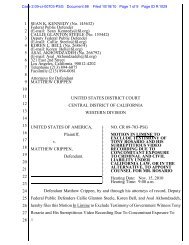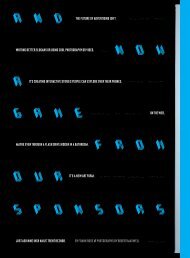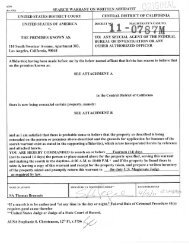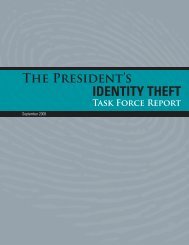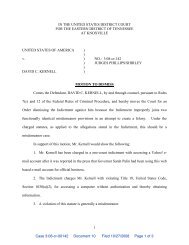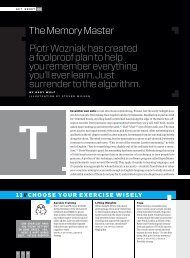Gerald Blanchard could hack any bank, swipe any jewel. On ... - Wired
Gerald Blanchard could hack any bank, swipe any jewel. On ... - Wired
Gerald Blanchard could hack any bank, swipe any jewel. On ... - Wired
- No tags were found...
Create successful ePaper yourself
Turn your PDF publications into a flip-book with our unique Google optimized e-Paper software.
theG e r a l dB l a n c h a r d<strong>could</strong> <strong>hack</strong>a n y b a n k ,s w i p e<strong>any</strong> <strong>jewel</strong>.T h e r ew a s n osecuritys y s t e mh e<strong>could</strong>n’tb e a t .<strong>On</strong> thet r a i l o f t h ew o r l d ’ smostingeniousthief.by j o s h u a h b e a r m a n
illustration by justin wood
The plane slowed and leveled out about a mile aboveground. Up ahead, theViennese castle glowed like a fairy tale palace. When the pilot gave the thumbsup,<strong>Gerald</strong> <strong>Blanchard</strong> looked down, checked his parachute straps, and jumpedinto the darkness. He plummeted for a second, then pulled his cord, slowing to anice descent toward the tiled roof. It was early June 1998, and the evening windwas warm. If it kept cooperating, <strong>Blanchard</strong> would touch down directly abovethe room that held the Koechert Diamond Pearl. He steered his parachutetoward his target. A couple of days earlier, <strong>Blanchard</strong> had appeared to be justanother twentysomething on vacation with his wife and her wealthy father.
he <strong>could</strong>n’t fence the piece, which he did hear the guide say was worth $2 million. Still,he found the thing mesmerizing and the challenge irresistible.He began to work immediately, videotaping every detail of the star’s chamber. (He evencoyly shot the no cameras sign near the <strong>jewel</strong> case.) He surreptitiously used a key toloosen the screws when the staff moved on to the next room, unlocked the windows, anddetermined that the motion sensors would allow him to move—albeit very slowly—insidethe castle. He stopped at the souvenir shop and bought a replica of the Sisi Star to get a feel forits size. He also noted the armed guards stationed at every entrance and patrolling the halls.But the roof was unguarded, and it so happened that one of the skills <strong>Blanchard</strong> had pickedup in his already long criminal career was skydiving. He had also recently befriended a Germanpilot who was game for a mercenary sortie and would help <strong>Blanchard</strong> procure a parachute.Just one night after his visit to the star, <strong>Blanchard</strong> was making his descent to the roof.Aerial approaches are a tricky business, though, and <strong>Blanchard</strong> almost overshot thecastle, slowing himself just enough by skidding along a pitched gable. Sliding downthe tiles, arms and legs flailing for a grip, <strong>Blanchard</strong> managed to save himself from fallingfour stories by grabbing a railing at the roof’s edge. For a moment, he lay motionless.Then he took a deep breath, unhooked the chute, retrieved a rope from his pack, wrappedit around a marble column, and lowered himself down the side of the building.Carefully, <strong>Blanchard</strong> entered through the window he had unlocked the previous day.He knew there was a chance of encountering guards. But the Schloss Schönbrunn wasa big place, with more than 1,000 rooms. He liked the odds. If he heard guards, he figured,he would disappear behind the massive curtains.The nearby rooms were silent as <strong>Blanchard</strong> slowly approached the display andremoved the already loosened screws, carefully using a butter knife to hold in placethe two long rods that would trigger the alarm system. The real trick was ensuring thatthe spring- loaded mechanism the star was sitting on didn’t register that the weightabove it had changed. Of course, he had that covered, too: He reached into his pocketand deftly replaced Elisabeth’s be<strong>jewel</strong>ed hairpin with the gift-store fake.Within minutes, the Sisi Star was in <strong>Blanchard</strong>’s pocket and he was rappelling down aback wall to the garden, taking the rope with him as he slipped from the grounds. Whenthe star was dramatically unveiled to the public the next day, <strong>Blanchard</strong> returned towatch visitors gasp at the sheer beauty of a cheap replica. And when his parachute waslater found in a trash bin, no one connected it to the star, because no one yet knew it wasmissing. It was two weeks before <strong>any</strong>one realized that the <strong>jewel</strong>ry had disappeared.Later, the Sisi Star rode inside the respirator of some scuba gear back to his homebase in Canada, where <strong>Blanchard</strong> would assemble what prosecutors later called, forlack of a better term, the <strong>Blanchard</strong> Criminal Organization. Drawing on his encyclopedicknowledge of surveillance and electronics, <strong>Blanchard</strong> became a criminal mastermind.The star was the heist that transformed him from a successful and experiencedthief into a criminal virtuoso.“Cunning, clever, conniving, and creative,” as one prosecutor would call him, <strong>Blanchard</strong>eluded the police for years. But eventually he made a mistake. And that mistake wouldtake two officers from the modest police force of Winnipeg, Canada, on a wild ride ofhigh tech capers across Africa, Canada, and Europe. Says Mitch McCormick, one ofthose Winnipeg investigators, “We had never seen <strong>any</strong>thing like it.”<strong>Blanchard</strong>pulled off his first heist when he was a 6-yearoldliving with his single mother in Winnipeg.The family <strong>could</strong>n’t afford milk, and oneday, after a long stretch of dry cereal, theboy spotted some recently delivered bottleson a neighbor’s porch. “I snuck over therebetween cars like I was on some kind of mission,”he says. “And no one saw me take it.”His heart was pounding, and the milk wassomehow sweeter than usual. “After that,”he says, “I was hooked.”<strong>Blanchard</strong> moved to Nebraska, startedgoing by his middle name, Daniel, andbecame an accomplished thief. He didn’tlook the part—slim, short, and bespectacled,he resembled a young Bill Gates—but he certainly played it, getting intoenough trouble to land in reform school.“The way I met Daniel was that he stolemy classroom VCR,” recalls Randy Flanagan,one of <strong>Blanchard</strong>’s teachers. Flanaganthought he might be able to straightenout the soft- spoken and polite kid, so hetook <strong>Blanchard</strong> under his wing in his homemechanicsclass.“He was a real natural in there,” Flanagansays. <strong>Blanchard</strong>’s mother remembers thateven as a toddler he <strong>could</strong> take <strong>any</strong>thingapart. Despite severe dyslexia and a speechimpediment, <strong>Blanchard</strong> “was an absolutegenius with his hands,” the teacher recalls.In Flanagan’s class, <strong>Blanchard</strong> learnedconstruction, wood working, model building,and automotive mechanics. The twobonded, and Flanagan became a father figureto <strong>Blanchard</strong>, driving him to and fromschool and looking out for him. “He <strong>could</strong>see that I had talent,” <strong>Blanchard</strong> says.“And he wanted me to put it to good use.”Flanagan had seen m<strong>any</strong> hopeless kidsstraighten out—“You never know when something’sgoing to change forever for someone,”he says—and he still hoped that would happento <strong>Blanchard</strong>. “But Daniel was the typeof kid who would spend more time tryingto cheat on a test than it would have takento study for it,” Flanagan says with a laugh.
courtesy of gerald blanchardIn fact, by early in his high school years,<strong>Blanchard</strong> had already abandoned his afterschooljob stocking groceries to pursuemore lucrative opportunities, like fencingtens of thousands of dollars in goodsstolen by department store employees hehad managed to befriend. “I <strong>could</strong> just tellwho would work with me,” he says. “It’s agift, I guess.”<strong>Blanchard</strong> began mastering the workingsof myriad mechanical devices and electronics.He became obsessed with cameras andsurveillance: documenting targets, his ownexploits, and his huge piles of money. Befittinga young tech enthusiast, he emptied anentire RadioS<strong>hack</strong> one Easter Sunday. Atage 16, he bought a house with more than$100,000 in cash. (He hired a lawyerto handle the money and sign thedeal on his behalf.) When he movedin, <strong>Blanchard</strong> told his mother thatthe home belonged to a friend. “Shelooked the other way,” <strong>Blanchard</strong> says.“And I tried to keep it all from her.”Around this time, <strong>Blanchard</strong>was arrested for theft. He did severalmonths behind bars and wasreleased into Flanagan’s custodyafter the older man vouched for himat a hearing. “He was great with our ownkids,” Flanagan says. “And I still thoughthe might come around.” But <strong>Blanchard</strong>’sburgeoning criminal career was hard toignore, as he often flaunted his ill-gottengains. “I wasn’t surprised when the FBIcame knocking one day,” Flanagan says.“He’d pull out a fistful of hundreds and peelone off to pay for pizza.”In April 1993, <strong>Blanchard</strong> was nabbed bythe cops in Council Bluffs, Iowa, for a suspectedcar arson and brought back to policeheadquarters. “They kept me in the interrogationroom past midnight,” <strong>Blanchard</strong>says. “And at a certain point, I managed tosneak into the next room and slip throughthe tiles into the ceiling.” Undetected, heheard the cops run down the hall, thinkinghe’d gone out the fire escape. After waiting acouple of hours, <strong>Blanchard</strong> lowered himselfdown into the mostly empty station, stolea police coat, badge, radio, and revolver.After leaving a single bullet on the desk ofhis interrogator, he took the elevator to themain floor and strolled right past the frontdesk on his way out of the station. He hitchhikedat dawn back to Omaha on the back ofa motorcycle, holding his purloined policecap down in the wind. “Why are you wearing a uniform?” the driver asked. “Costumeparty,” <strong>Blanchard</strong> said as the sun came up. “Really fun time.”The next day, <strong>Blanchard</strong> was re- apprehended by a SWAT team, which had to useflash grenades to extricate him from his mother’s attic. But he surprised the cops byescaping yet again, this time from the back of a police cruiser. “They got out of the carand left the keys,” <strong>Blanchard</strong> says. “There was no barrier, so I fiddled with the cuffsuntil I got my hands in front of me, locked the doors, slipped up front, and put it ingear.” The authorities gave chase until <strong>Blanchard</strong> swerved into a steak-house parkinglot, fled on foot, and was finally recaptured.This time, <strong>Blanchard</strong> served four years and his sentence came with a deportationorder attached. In March 1997, he was released to his Canadian homeland and barredfrom returning to the US for five years.“After that,” Flanagan says, “I heard from Daniel once or twice a year, thanking mefor what I had done for him.” <strong>Blanchard</strong> sent pictures of himself vacationing aroundthe world, on exclusive beaches, posing in front of Viennese castles. He said he had hisown security business. “I wanted that to be true,” Flanagan says. “But I had a hunchhe was more likely in the anti- security business.”From left: <strong>Blanchard</strong>at age 8; with his thenwifeand father-in-law inVienna, 1998; <strong>Blanchard</strong>’sgirlfriend enjoying hisproceeds in 2006.in 2001, blanchard was driving around Edmonton when he saw a new branch ofthe Alberta Treasury <strong>bank</strong> going up. His internal algorithm calculated low risk, and hebegan to case the target meticulously. It had been three years since the Sisi Star theft,and it was time to try something big and new.As the <strong>bank</strong> was being built, <strong>Blanchard</strong> frequently sneaked inside—sometimes atnight, sometimes in broad daylight, disguised as a delivery person or constructionworker. There’s less security before the money shows up, and that allowed <strong>Blanchard</strong> toplant various surveillance devices in the ATM room. He knew when the cash machineswere installed and what kind of locks they had. He ordered the same locks online andreverse engineered them at home. Later he returned to the Alberta Treasury to disassemble,dis able, and remount the locks.The take at this <strong>bank</strong> was a modest 60 grand, but the thrill mattered more than themoney <strong>any</strong>way. <strong>Blanchard</strong>’s ambition flowered, as did his technique. As Flanagan had1 0 3
observed, <strong>Blanchard</strong> always wanted to beat the system, and he was getting better at it.<strong>Blanchard</strong> targeted a half- dozen <strong>bank</strong>s over the next few years. He’d get in throughthe air- conditioning ductwork, at times contorting his body to fit inside really tightspaces. Other times, he would pick the locks. If there were infrared sensors, he’d useIR goggles to see the beams. Or he’d simply fool the sensor by blocking the beamwith a lead film bag.He assembled an arsenal of tools: night- vision cameras, long-range lenses, highgainantennas that <strong>could</strong> pick up the feeds from the audio and video recorders he hidinside a <strong>bank</strong>, scanners programmed with the encryption keys for police frequencies.He always had a burglary kit on hand containing ropes, uniforms, cameras, and microphones.In the Edmonton branch of the Bank of Nova Scotia, which he hit in 2002, heinstalled a metal panel near the AC ducts to create a secret crawl space that he <strong>could</strong>disappear into if surprised by police.Such evasive action was never required, however, in part because <strong>Blanchard</strong> had alsomemorized the mechanics of the Mas- Hamilton and La Gard locks that m<strong>any</strong> <strong>bank</strong>sused for their ATMs. (These are big, complicated contraptions, and when police laterinterrogated <strong>Blanchard</strong>, they presented him with a Mas- Hamilton lock in dozens ofpieces. He stunned them by reassembling it in 40 seconds.)<strong>Blanchard</strong> also learned how to turn himself into someone else. Sometimes it wasjust a matter of donning a yellow hard hat from Home Depot. But it <strong>could</strong> also be moreinvolved. Eventually, <strong>Blanchard</strong> used legitimate baptism and marriage certificates—filled out with his assumed names—to obtain real driver’s licenses. He would even takedriving tests, apply for passports, or enroll in college classes under one of his m<strong>any</strong>aliases: James Gehman, Daniel Wall, or Ron Aikins. With the help of makeup, glasses,or dyed hair, <strong>Blanchard</strong> gave James, Daniel, Ron, and the others each a different look.Over the years, <strong>Blanchard</strong> procured and stockpiled IDs and uniforms from varioussecurity companies and even law enforcement agencies. Sometimes, just for fun andto see whether it would work, he pretended to be a reporter so he <strong>could</strong> hang out withcelebrities. He created VIP passes and applied for press cards so he <strong>could</strong> go to NHLplayoff games or take a spin around the Indianapolis Motor Speedway with racinglegend Mario Andretti. He met the prince of Monaco at a yacht race in Monte Carloand interviewed Christina Aguilera at one of her concerts.That’s where, in July 2000, <strong>Blanchard</strong> met Angela James. She had flowing black hairand claimed to work for Ford Models. They got along right away, and <strong>Blanchard</strong> waselated when she gave him her number. He sensed that the teenager was “down withcrime”—someone he <strong>could</strong> count on for help.<strong>Blanchard</strong> liked having a sidekick. James was a fun, outgoing party animal who hadplenty of free time. She eventually began helping <strong>Blanchard</strong> on <strong>bank</strong> jobs. They’d tagteamon daylight reconnaissance, where her striking looks provided a distraction while<strong>Blanchard</strong> gathered information. At night, she’d be the lookout.Though they were never involved romantically, James and <strong>Blanchard</strong> traveledtogether around the world, stopping in the Caribbean to stash his loot in offshoreaccounts. They camped out at resorts in Jamaica and the Turks and Caicos islands,depositing money in $10,000 increments into some of <strong>Blanchard</strong>’s 13 pseudonymouslyheld accounts. The money in the offshore accounts was to pay for his jet-setting lifestyle.The money back in Canada would <strong>bank</strong>roll his real estate transactions. Thefunds sitting in Europe were there, well, in case <strong>any</strong>thing happened to him.After midn ghton Saturday, May 15, 2004, as the northernprairie winter was finally giving wayto spring, <strong>Blanchard</strong> walked up to the frontdoor of the Canadian Imperial Bank ofCommerce in the Mega Centre, a suburbandevelopment in Winnipeg. He quickly jimmiedthe lock, slipped inside, and lockedthe door behind him. It was a brand-newbranch that was set to open for businesson Monday, and <strong>Blanchard</strong> knew that thecash machines had been loaded on Friday.
Thorough as ever, <strong>Blanchard</strong> had spentm<strong>any</strong> previous nights infiltrating the <strong>bank</strong>to do recon or to tamper with the locks whileJames acted as lookout, scanning the vicinitywith binoculars and providing updatesvia a scrambled-band walkie-talkie. He hadgotten his ATM-cracking routine down to where he needed only 90 seconds after thealarm tripped to finish and escape with his score.As <strong>Blanchard</strong> approached, he saw that the door to the ATM room was unlocked andwide open. Sometimes you get lucky. All he had to do was walk inside.From here he knew the drill by heart. There were seven machines, each with fourdrawers. He set to work quickly, using just the right technique to spring the machinesput a transmitter behind an electrical outlet,a pin hole video camera in a thermostat,and a cheap baby monitor behind thewall. He had even mounted handles on thedrywall panels so he <strong>could</strong> remove themto enter and exit the ATMroom. <strong>Blanchard</strong> had alsoopen without causing <strong>any</strong> telltale damage. Well rehearsed, <strong>Blanchard</strong> wheeled outboxes full of cash and several money counters, locked the door behind him, and headedto a van he had parked nearby.Eight minutes after <strong>Blanchard</strong> broke into the first ATM, the Winnipeg Police Servicearrived in response to the alarm. However, the officers found the doors locked andassumed the alarm had been an error. As the police pronounced the <strong>bank</strong>secure, <strong>Blanchard</strong> was zipping away with more than half a million dollars.taken detailed measurementsof the room and setWinnipeg police officersLarry LevasseurThe following morning was a puzzler for authorities. There were noindications of damage to the door, no fingerprints, and no surveillanceup a dummy version in a (left) and Mitchrecordings—<strong>Blanchard</strong> had stolen the hard drives that stored footage fromMcCormick werefriend’s nearby machine relentless in theirthe <strong>bank</strong>’s cameras. Moreover, <strong>Blanchard</strong>’s own surveillance equipmentshop. With practice, he had pursuit of <strong>Blanchard</strong>. was still transmitting from inside the ATM room, so before he skippedAPR 20100 0 0
town, he <strong>could</strong> listen in on investigators. He knew their names; he knew their leads. Hewould call both the <strong>bank</strong> manager’s cell phone and the police, posing as an anony mousinformant who had been involved in the heist and was swindled out of his share. It was thecontractors, he’d say. Or the Brinks guy. Or the maintenance people. His tips were especiallyconvincing because he had a piece of inside information: <strong>On</strong>e of the <strong>bank</strong>’s ATMs wasleft untouched. <strong>Blanchard</strong> had done that on purpose to make it easier to sow confusion.With the cops outmatched and chasing red herrings, the Winnipeg <strong>bank</strong> job lookedlike a perfect crime. Then officials got a call from a vigilant employee at a nearby Walmart,which shared a large parking lot with the <strong>bank</strong>. He had been annoyed at peopleleaving cars there, so he took it upon himself to scan the lot. <strong>On</strong> the night of the breakin,he spotted a blue Dodge Caravan next to the <strong>bank</strong>. Seeing a dolly and other oddequipment inside, he took down the license plate number. Police ran it. The vehiclehad been rented from Avis by one <strong>Gerald</strong> Daniel <strong>Blanchard</strong>.blanchard’s use of his real name was as careless as the fingerprints police foundinside the getaway van recovered by the rental comp<strong>any</strong>. Soon the cops were on his tail.Because of the heist’s sophistication, the investigation fell to Winnipeg’s Major Crimesunit. But <strong>Blanchard</strong>—now divorced and living with his girlfriend, Lynette Tien—learnedthat he had become a suspect, so he stayed out of their sights. Two years passed, andm<strong>any</strong> of the investigators who had dealt with the initial leads retired or were transferred.The case went cold until early 2006, when Mitch McCormick, a veteran officer in hisfifties, started working on major crimes and decided to take a look at the unsolved robbery.Intrigued, he called his longtime colleague Larry Levasseur, a wiretap ace whohad just been transferred to the Commercial Crimes division.In <strong>Blanchard</strong>’s m<strong>any</strong> years of crime, gunshad never been involved. But the Marriottsuites soon turned into a hostage situation.<strong>On</strong>e night in early February, McCormick and Levasseur sat down at the King’s Headbar, a favorite local police haunt. Levasseur went through several pints of amber ale,and McCormick had his usual double rye and a Coke tall. McCormick filled him in on the<strong>Blanchard</strong> leads and gave him the case file to take home.The two were interested, but McCormick’s boss was skeptical. Why spend money chasinga criminal who was committing most of his crimes outside their jurisdiction? Eventually,though, the two stubborn cops made such a fuss that the department brass relented. “Butwe got no resources and had to put together a task force out of thin air,” McCormick says. “Itwas like the set of Barney Miller. We knew it was bad when we had to buy our own Post-its.”They quickly started filling up those Post-its and arranging them on a corkboard,mapping <strong>Blanchard</strong>’s sprawling network. The case was overwhelming, but they eventuallyunraveled his tangle of 32 false names. Their preliminary checks also showed that<strong>Blanchard</strong> was a person of interest in m<strong>any</strong> crimes, including the unsolved theft of the SisiStar nearly 10 years earlier. They assembled roughly 275 pages of documentation, enoughto persuade a judge to let them tap <strong>Blanchard</strong>’s 18 phones. Now they were in business. Theywere taking a professional flier on this case. They dubbed their investigation Project Kite.usually wiretaps are a waiting game; cops will listen to secretive organized crime syndicatesfor years, hoping for one little slip. But <strong>Blanchard</strong> was surprisingly loose- lipped.The second weekend the wires went live, McCormick and Levasseur heard him direct-ing a team of underlings in a product- returnfraud at a Best Buy. More scams followed.They heard him wheeling and dealing inreal estate. They listened in as he plannedhis next <strong>bank</strong> job. They learned about a vastnetwork of sophisticated crime. For a smartcriminal, McCormick and Levasseur thought,this guy sure did talk a lot.Then, on November 16, 2006, <strong>Blanchard</strong>got a particularly intriguing call.“Hello, Danny,” a man with a thick Britishaccent said. “Are you ready? I have a job foryou. How soon can you get to Cairo?”McCormick and Levasseur listened withastonishment as <strong>Blanchard</strong> immediatelyset about recruiting his own small teamto meet up with another group in Egypt.<strong>Blanchard</strong> referred to his contact as theBoss—he <strong>could</strong>n’t pronounce his real name—and explained to his cohorts that therewas money to be made with this guy.James was in. But her parents were in townvisiting, and her mother didn’t want her to go.James put her mom on the phone so <strong>Blanchard</strong><strong>could</strong> talk the woman into giving herdaughter permission to join him in a criminalescapade across the globe. “We’regoing to make a lot of money,” he said.“But don’t worry. Everything will be fine.”Several of his regular guys <strong>could</strong>n’tmake it, so <strong>Blanchard</strong> called his neighbor,a Congolese immigrant named BalumeKashongwe. When <strong>Blanchard</strong> explainedthe job, Kashongwe volunteered rightaway. With his team assembled, <strong>Blanchard</strong>thought, “This is going to be easy. What<strong>could</strong> go wrong?” Just a few hours afterthe Boss’ call, <strong>Blanchard</strong>, Kashongwe, andJames were in the air, en route to Cairo.blanchard had first met the Boss a fewmonths earlier in London at an electronicsstore. He <strong>could</strong> tell they were kindred spiritsby a glance at the Boss’ purchases: eight DVRrecorders. <strong>Blanchard</strong> knew you didn’t buy aload like that for <strong>any</strong>thing but sur veillance.The two struck up a conversation.Later that day, a car arrived to take<strong>Blanchard</strong> to a London café, where the Bossand a dozen Kurdish henchmen, most fromnorthern Iraq, were waiting in the basement,smoking hookahs. The Boss filled <strong>Blanchard</strong>in on his operation, which spanned Europeand the Middle East and included variouscriminal activities, including counterfeitingand fraud. The latest endeavor was calledskimming: glean- | continued on page 1081 0 6
Art of the Stealcontinued from page 106ing active debit and credit card numbersby patching into the ISDN lines that companiesuse to process payments. The groupmanufactured counterfeit cards magnetizedand embossed with the stolen numbers andthen used them to withdraw the maximumdaily limits before the fraud was reported.It was a lucrative venture for the Boss’ network,which funneled a portion of its taketo Kurdish separatists in Iraq.Living up to his new nickname, the Bossgave <strong>Blanchard</strong> a trial job: taking 25 cards toCanada to retrieve cash. <strong>Blanchard</strong> returnedto London with $60,000, and the Boss waspleased. He found the younger man charmingand steady as well. “We have somethingbig coming,” he told <strong>Blanchard</strong> over dinner ata Kurdish restaurant. “I’ll keep you posted.”With that job now at hand, <strong>Blanchard</strong>’screw arrived in Egypt and checked intothe Cairo Marriott Hotel & Omar KhayyamCasino, settling into a couple of suites withsweeping views of the Nile. The next day,three men <strong>Blanchard</strong> remembered fromthe London café showed up. They broughtroughly 1,000 pirated cards, which thegroup immediately started using in teamsof two. Kashongwe and the Kurds from Londonblended in easily. <strong>Blanchard</strong> and Jamesbought burkas in the souk as disguises. TheBoss directed operations from London.They went from ATM to ATM for 12 hoursa day, withdrawing Egyptian pounds andstuffing the bills into backpacks and suitcases.<strong>Blanchard</strong> and James folded their cashinto pouches hidden beneath the burkas.And as usual, <strong>Blanchard</strong> filmed the entireadventure: the wandering through Cairo’sByzantine streets, the down time in the city,the money pouring in.Back in their bare-bones Winnipeg office,McCormick and Levasseur were monitoringtheir target’s email accounts and calls backto Tien, who was managing travel arrangementsand other administrative details from<strong>Blanchard</strong>’s condo in Vancouver. The Canadiancops were stunned. They never imaginedthey’d come across <strong>any</strong>thing this big.They learned about the loot piling up 4 feethigh in the suites at the Marriott. And thenthey learned that everything had gone to hell.In the course of a week, the team collectedthe equivalent of more than $2 million.But the individual ATM payouts weresmall, so after a couple of days <strong>Blanchard</strong>sent Kashongwe south to Nairobi, Kenya,with 50 cards to find more- generousmachines. Kashongwe had no cell phone,though, and he went suspiciously incommunicado.Soon it became clear that Kashongwewas AWOL. <strong>Blanchard</strong> wasn’t happy.And neither was the Boss.<strong>Blanchard</strong> was in over his head. In hism<strong>any</strong> years of crime, guns had never beeninvolved. The Boss, however, seemedinclined to change that. <strong>Blanchard</strong> promisedto track down Kashongwe. “Good,” theBoss said. “Other wise, we’ll find him. Andhe won’t be happy when we do.”McCormick and Levasseur listened to thecalls in and out of Cairo as temperaturesrose. They <strong>could</strong> hear <strong>Blanchard</strong> callingTien back in Vancouver, trying desperatelyto reach Kashongwe. He called Kashongwe’ssister in Brussels and his brother in Ottawa.He sounded frantic at times. But <strong>Blanchard</strong>had no luck; Kashongwe had vanished.Things took another turn for the worsewhen the Boss told <strong>Blanchard</strong> he <strong>could</strong>n’tleave Cairo until the missing cards wereaccounted for. Two more men arrived to“keep an eye on things.” The Marriott suiteshad turned into a hostage scene.But <strong>Blanchard</strong>’s natural charm workedon the Boss, too. He took full responsibility,promised to personally pay back Kashongwe’sshare, and calmly argued that Jamesdidn’t have <strong>any</strong>thing to do with the doublecross. The Boss eventually told his men to letJames go. Then he agreed to let <strong>Blanchard</strong>travel to London to smooth things out inperson. “I’m pretty honest about that kindof thing,” <strong>Blanchard</strong> says. “And the Boss<strong>could</strong> see that I was taking responsibilityfor my guy.”The two decided to set aside the Kashongweproblem in the interest of business.The Boss’ men would meet <strong>Blanchard</strong> backin Canada with a new batch of cards. “Afterall,” <strong>Blanchard</strong> says, “why fight when therewas more money to be made?”<strong>On</strong> December 3, 2006, <strong>Blanchard</strong> landedin Vancouver, where he immediately renteda car and drove straight to a branch of theBank of Nova Scotia, 65 miles east in Chilliwack.He’d started prepping to burglarizethe <strong>bank</strong> before his trip. The Kashongwefiasco ended up nearly costing <strong>Blanchard</strong>money, and now he was after a siz able payday.Chilliwack was good for $800,000, hefigured, and he would work through theholidays to get it done.McCormick and Levasseur had both beenon duty during the holidays before, but neverhad a case so consumed them. They werespending 18-hour days in their makeshiftheadquarters or at the King’s Head, poringover transcripts and evidence. They got noovertime pay. The strain grew, as did thepressure from higher-ups.Lucky for them, <strong>Blanchard</strong>’s disarray wascompounding his mistakes. As soon as hetouched down, McCormick and Levasseurpicked up <strong>Blanchard</strong> live, discussing Cairo,his next <strong>bank</strong>, and the potential whereaboutsof Kashongwe. While <strong>Blanchard</strong> was en routeto Chilliwack, they listened to him and theBoss discuss details about the arrival of ateam in Montreal the next day.McCormick and Levasseur called officialsat the Montreal airport with names and flightinformation. As the targets strode throughthe airport, the cops swarmed in. The teamwas detained, and police seized dozens ofblank credit cards, a card writer, and computersoverflowing with evidence that filledin the blanks on the Cairo operation. To topit off, the hard drives also contained some of<strong>Blanchard</strong>’s comprehensive amateur crimevideo of that job. Now the police <strong>could</strong> notonly hear him talking about crimes, they<strong>could</strong> see him committing them.The Boss phoned the very next day, panicked.But the call caught <strong>Blanchard</strong> at aninopportune moment. “I can’t talk right now,”<strong>Blanchard</strong> whispered. “I’m doing my thinginside the <strong>bank</strong> right now.” It was 12:30 am,and <strong>Blanchard</strong> was crawling through the<strong>bank</strong>’s ductwork.“Listen, my guys got arrested in the airport,and I need to find out why,” the Bosssaid. <strong>Blanchard</strong> was making his way painstakinglythrough the air vents, en route tothe ATM room. His earpiece was taped inand the phone was on auto- answer, in casehe got a call that the police were nearby.“What’s going on with my guys in Montreal?”1 0 8 APR 2010
the Boss demanded. “They got pulled in!”“I have no idea,” <strong>Blanchard</strong> said softly.“But it’s too much of a coincidence that customsknew. The phones must be tapped.”The Boss pressed on, asking for newsabout Kashongwe, but <strong>Blanchard</strong> interrupted.“I’m looking down. There’s asecurity guard down there right now,” hebreathed. He was deep into the building,making it hard to shimmy his way out incase he needed an emergency escape. “Ihave too much invested in this job,” he said.“I have to go.”“We need to fix this, Danny,” the Boss said.As <strong>Blanchard</strong> whispered back, McCormickand Levasseur were triangulating thecall’s location. Now they knew <strong>Blanchard</strong>was targeting Chilliwack’s Bank of NovaScotia. In late January, investigators fromToronto, Edmonton, and Vancouver as wellas provincial police and the Mounties hadjoined McCormick and Levasseur’s smalloperation. “Project Kite was ready to bereeled in,” McCormick says.At 4 am on January 23, 2007, more thana dozen SWAT team members swarmed<strong>Blanchard</strong>’s Vancouver condo, where theyfound <strong>Blanchard</strong> and Tien. Several othersearch warrants were executed simultaneouslyacross Canada, turning up half a dozenaccomplices, including Angela James and<strong>Blanchard</strong>’s cousin Dale Fedoruk.<strong>Blanchard</strong> was busted. At his variousresidences and storage facilities, policeconfiscated 10 pallets of material: 60,000documents, cash in various currencies,smoke bombs, firearms, and 300 electronicdevices, including commercial card printers,card readers, and all manner of surveillanceequipment. In his condo, police discovereda hidden room stocked with burglary kitsand well- organized, itemized documentationof all <strong>Blanchard</strong>’s fake identities. Hewas initially charged with 41 crimes, rangingfrom fraud to possession of instrumentsfor forging credit cards.The Boss called <strong>Blanchard</strong> in jail on theprison phone. “Why you, Danny?” he asked.“Why would little Winnipeg go to all thattrouble? You must have upset the establishment.It’s like we say in England: You fuckwith the Queen, and they fuck with you.”As McCormick and Levasseur listened in,<strong>Blanchard</strong> said it wasn’t the establishment,or the Queen. “It was these Keystone Kopsout here in Winnipeg.”<strong>Blanchard</strong> says that he <strong>could</strong> have escapedfrom jail again, but there was no point. Thepolice had all the evidence, including 120video- and audio tapes detailing everything.They’d just find him again, and he was tiredof running <strong>any</strong>how.<strong>Blanchard</strong> refused to make statementsabout <strong>any</strong> of his associates, but he eventuallydecided to cooperate with authoritiesabout his own case. “He’s a flamboyantguy,” McCormick says. “And an extrovert,recording everything. Some part of him justwanted to tell his story.” He had anotherincentive, too: Revealing his methods,which would help the <strong>bank</strong>ing industryimprove its security practices, <strong>could</strong> earnhim a lighter prison sentence.The first day that Levasseur sat down with<strong>Blanchard</strong> in Vancouver, the investigator feltlike he “was talking to a wall.” But in laterinterviews, <strong>Blanchard</strong> became more courteousand helpful. Finally, after some negotiationsthrough his lawyer, <strong>Blanchard</strong> offeredto take them to the Sisi Star. “It’s right here inmy grandmother’s basement in Winnipeg,”he said. <strong>Blanchard</strong> had tried to steer clearof his family since his arrest; he didn’t wantto embarrass them further. But now he hadto call. “I need to come to the house,” he said.“And I’m bringing the police.”<strong>Blanchard</strong>, in handcuffs and leg s<strong>hack</strong>les,hugged his grand mother at the door and tookMcCormick and Levasseur directly into thebasement. He disappeared into a crawl spacewith Levasseur. It was quiet except for thesound of them grappling with the insulation.Eventually, Levasseur removed a square ofStyrofoam and pulled out the star.They brought it out into the light, wherethe detectives marveled at the beauty ofthe piece. They’d never seen <strong>any</strong>thing likeit. That kicked off nearly a month of debriefing.The cops had gotten some stuff right,but <strong>Blanchard</strong> set them straight on the rest.“Never in policing does the bad guy tell you,‘Here’s how I did it, down to the last detail,’”McCormick says. “And that’s what he did.”After spending so much time chasing<strong>Blanchard</strong>—and then talking to him—McCormick and Levasseur developeda grudging regard for his abilities. And<strong>Blanchard</strong> grew to admire their relentlessinvestigation. Like a cornered <strong>hack</strong>er whotrades his black hat for white, <strong>Blanchard</strong>took on a new challenge: working the systemfrom the inside. He provided such goodinformation that McCormick and Levasseurwere able to put together an eight-hour presentationfor law enforcement and <strong>bank</strong>ingprofessionals. “When those guys hear what<strong>Blanchard</strong> told us,” McCormick says, “youcan hear their assholes pucker shut.”<strong>Blanchard</strong>’s full participation came underconsideration when he pled guilty to 16charges on November 7, 2007. He agreed tosell his four condos and pay restitution tothe Canadian government. And he was willingto take a longer sentence for himself inexchange for leniency toward his co accused,whom he refused to testify against. Noneof his partners served jail time.<strong>Blanchard</strong> also surprised the court byhaving his lawyer issue an unusual statement:an expression of gratitude for beingarrested. “My client wishes to recognizethat this huge lie that he had been living<strong>could</strong> now finally fall apart.” It added that<strong>Blanchard</strong> was looking forward to movingon. “He recognizes that the men and womenof the Winnipeg Police Service made thatall possible.”Instead of the maximum of 164 years,<strong>Blanchard</strong> got eight. And then last summer,after serving less than two, he was releasedinto carefully guarded probation. He nowlives in a Vancouver halfway house, wherehe is prohibited from going <strong>any</strong>where nearcertain types of surveillance equipment andtalking to <strong>any</strong> of his former associates. <strong>On</strong>eof the people he can call is Randy Flanagan,his old mentor from high school.“He filled me in about the past 10 years,”Flanagan says. “I was surprised, but not thatsurprised, about what our little former sonhad been up to.” <strong>Blanchard</strong> told Flanagan hewanted to turn his life around. Working withMcCormick and Levasseur had convincedhim that he <strong>could</strong> become a consultant tothe <strong>bank</strong>s. “Who knows?” Flanagan says.“Maybe he will get that security business hetalked about off the ground after all.”The judge had a similar thought during<strong>Blanchard</strong>’s plea hearing. The <strong>bank</strong>s “shouldhire him and pay him a million dollars ayear,” he said. And right before sentencing,the judge turned directly to <strong>Blanchard</strong>. “Ithink that you have a great future ahead ofyou if you wish to pursue an honest style oflife,” he said. “Although I’m not prepared tosign a letter of reference.” joshuah bearman (joshuah_bearman@hotmail.com) wrote about rescuingAmerican hostages from Iran in issue 15.05.1 1 2 APR 2010



